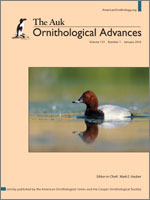The discovery of spatial patterns in naturally occurring isotopes (e.g., δ2H, δ13C) at continental scales has been tremendously important in providing a method to infer potential breeding and wintering origins of migratory animals through assignment to tissue-specific isoscapes. Single-isotope (i.e. δ2H) assignments of birds to molting origins in South America have been limited by the lack of strong spatial gradients in precipitation δ2H there. We integrated an mvnpdf (multivariate normal probability density function) approach using δ2H and δ13C values in tail feathers to determine wintering origins of adult Barn Swallows (Hirundo rustica) breeding in eastern Canada (n = 208). Spatial assignments were conducted using precipitation (δ2H) and theoretical plant-based (δ13C) isoscapes for South America calibrated for feathers of Nearctic–Neotropical migrant songbirds. We also measured feather δ34S values of Barn Swallows equipped with geolocators (n = 9) and of a larger group of Barn Swallows (n = 121) of unknown molt origin to assess the possibility of using this isotope to identify birds molting in coastal habitats and for which the terrestrial δ2H isoscapes would potentially be invalid. We constrained the mvnpdf assignment to areas generally south of the Amazon basin, based on data retrieved from Barn Swallows fitted with archival light-level geolocators from Ontario (n = 3) and New Brunswick (n = 11), Canada, which showed consistent overwintering fidelity to south-central South America. The majority of birds from our breeding populations were assigned to south-central Brazil. Results from the δ34S analysis indicate that a threshold of 11‰ may be appropriate to constrain the use of terrestrial δ2H isoscapes in South America. Our results refine the toolbox available to examine migratory connectivity in species that molt on their South American wintering grounds and underline the value of using multiple proxies for assignments of animals to spatial origin.
How to translate text using browser tools
30 December 2015
An isotope (δ34S) filter and geolocator results constrain a dual feather isoscape (δ2H, δ13C) to identify the wintering grounds of North American Barn Swallows
Keith A. Hobson,
Kevin J. Kardynal
ACCESS THE FULL ARTICLE

The Auk
Vol. 133 • No. 1
January 2016
Vol. 133 • No. 1
January 2016
carbon-13
deuterium
geolocators
isoscape
isotopic assignment
migratory connectivity
multivariate normal probability density function




